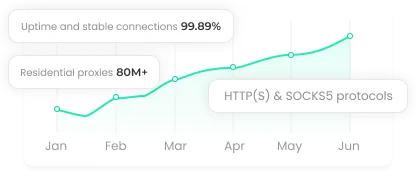How to Choose the Right SOCKS5 Proxy for Secure Browsing
The web has become a territory filled with trackers, restrictions, and hidden threats. Navigating it safely takes more than a password and antivirus. A SOCKS5 proxy provides a fast, flexible, and highly protective way to maintain your anonymity. Unlike traditional HTTP proxies, SOCKS5 operates at a lower network layer. It handles diverse traffic types without imposing strict limitations, making it ideal for everything from secure browsing to anonymous file transfers, ad verification, and web scraping.

What Is a SOCKS5 Proxy
SOCKS5, short for "Socket Secure version 5," is an internet protocol that routes data between your device and a server via an intermediary. Unlike HTTP proxies, which only handle web traffic, SOCKS5 supports all types—FTP, SMTP, P2P, you name it.
Why it stands out:
Handles all traffic types without discrimination
Supports authentication for secure access
Offers stronger anonymity than HTTP proxies
Reduces the risk of misinterpreted data packets
A reliable provider, like Swiftproxy, offers fast SOCKS5 servers, secure authentication, and global IP coverage—perfect for personal and business users alike.
Why Choose a SOCKS5 Proxy for Secure Browsing
Security-focused users gravitate toward SOCKS5 for one reason: it protects your online footprint without slowing you down.
IP Masking
Your real IP gets replaced with the proxy's. Websites see only the proxy address, keeping your location and identity hidden.
Geo-Unblocking
Access content from anywhere. SOCKS5 makes it appear as if you're browsing from a different country—perfect for streaming, research, or market testing.
Compatibility Across Protocols
HTTP proxies are limited. SOCKS5 isn't. Torrenting, gaming, live streaming, remote server management—it handles it all.
Reduced Latency
No packet rewriting. No extra processing. Just fast, uninterrupted traffic.
Choosing the right provider is critical. Swiftproxy delivers high-speed connections, IP rotation, and near-perfect uptime to keep your browsing secure and efficient.
How to Configure a SOCKS5 Proxy on Different Devices
Windows:
Open browser settings
Go to Network Settings or use a proxy extension
Select Manual Proxy Configuration
Enter the SOCKS5 server IP and port
Choose SOCKS5 as the proxy type
macOS:
System Preferences > Network
Select your active connection (Wi-Fi or Ethernet)
Click Advanced > Proxies tab
Check SOCKS Proxy
Enter your IP and port
Apply changes and reconnect
Using a trusted provider simplifies setup with step-by-step guides compatible across devices and applications.
Tips for Secure SOCKS5 Operation
Even the best proxy is only as effective as its implementation. Here's how to maximize security:
Choose a Reputable Provider
Free proxies can log data, host malware, or provide unstable IPs. Stick with providers like Swiftproxy for secure, authenticated access.
Enable Authentication
SOCKS5 supports username and password authentication. Always enable it to prevent unauthorized use.
Pair With Encryption When Needed
SOCKS5 doesn't encrypt traffic. Use HTTPS or SSH tunnels for sensitive data.
Rotate IPs Regularly
For tasks like web scraping or ad verification, IP rotation prevents blocks and detection. Swiftproxy offers advanced rotation with diverse IP pools.
Monitor Usage
Track bandwidth, performance, and traffic. Swiftproxy provides dashboards for real-time monitoring, ensuring efficiency.
Conclusion
Setting up a SOCKS5 proxy isn't just a tech task—it's a strategic move for online safety and freedom. With support for diverse traffic, low latency, and broad compatibility, SOCKS5 fits casual users and professionals alike.
Remember the provider matters. Swiftproxy delivers fast, stable, and secure SOCKS5 connections with global coverage, flexible plans, and reliable performance. Choose wisely, set it up correctly, and browse confidently.

















































